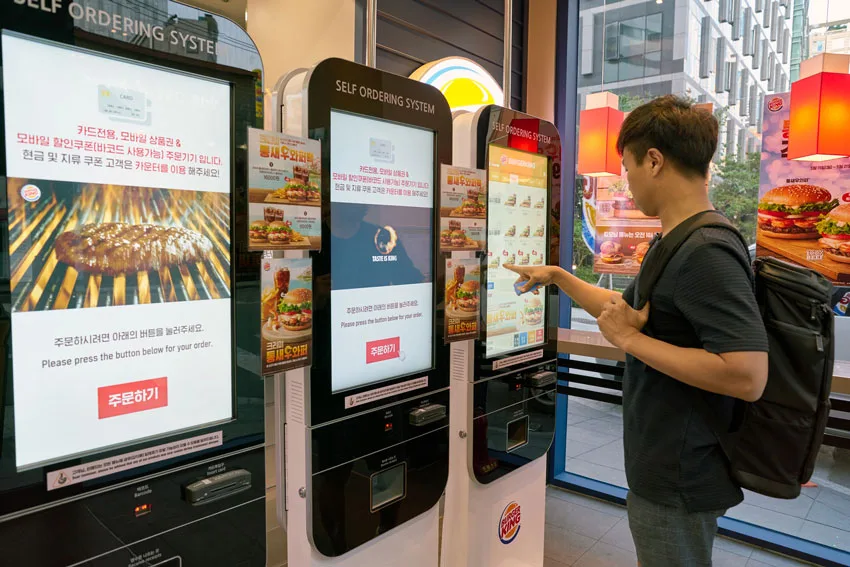In the dining industry, technology is leading the way to faster, more efficient customer experiences. Today’s diners crave convenience, accuracy, and personalization. In this environment, restaurants that fail to adapt risk losing relevance and revenue.
A self-ordering kiosk is one of the most powerful tools for meeting these demands. Once considered optional, kiosks have become necessary for successful restaurants. They make operations efficient, improve customer satisfaction, and drive profitability. This technology is changing restaurants’ operations, from quick-service chains to full-service establishments.
Data underscores this shift. By June 2023, the number of restaurant kiosks globally reached nearly 350,000. It reflects a 43% growth in just two years. The market for self-order kiosks is projected to expand at a compound annual growth rate of 7.1% through 2030. As customer expectations continue to rise, integrating a self-ordering kiosk is necessary.
Self-Ordering Kiosk for Restaurants: A Modern Solution
A self-ordering kiosk for restaurants is a solution that addresses the core challenges faced by restaurant operators. Long wait times, order inaccuracies, and staffing shortages are just a few issues that kiosks effectively solve.
Customers interact with kiosks to browse menus, customize orders, and complete payments independently. This eliminates the need for staff to take orders. It can free them to focus on food preparation and enhance the dining experience. Customers gain control over their experience, while restaurants benefit from increased efficiency and accuracy.
These kiosks aren’t limited to fast food or quick-service restaurants. Full-service establishments also adopt them to offer faster, more interactive ordering processes. Servers can focus on hospitality and upselling high-value menu items.
Shifting Customer Expectations Demand Innovation
Modern customers are tech-savvy and expect restaurants to offer solutions that match their lifestyles. A food-ordering kiosk caters to these expectations by delivering convenience and autonomy.
In particular, Gen Z customers are driving this trend. Over 91% of Gen Z diners prefer restaurants equipped with kiosks. This data demonstrates a growing demand for technology-integrated dining experiences. Customers of all demographics accept kiosks for their ability to reduce wait times.
Post-pandemic, safety has also become a priority for diners. Contactless ordering through kiosks addresses these concerns while maintaining the efficiency customers expect. Integrating kiosks allows restaurants to position themselves as forward-thinking and customer-focused establishments.
Operational Efficiency Drives Profitability
A self-ordering kiosk changes restaurant operations. With kiosks handling order placement and payment processes, restaurants can reallocate staff to other areas. Examples include meal preparation and table service.
Efficiency translates directly into profitability. Kiosks improve table turnover rates, allowing restaurants to serve more customers during peak hours. They also reduce errors caused by miscommunication between customers and staff. It helps make sure that their staff prepares orders exactly as requested.
Restaurants using kiosks report higher average check sizes. Kiosks suggest upsells during the ordering process. This automated upselling often outperforms human efforts, increasing revenue without pressuring customers. For example, McDonald’s saw a 6% rise in annual sales across North America after implementing self-order kiosks. This technology supports restaurants to present customers with visually appealing add-ons and personalized suggestions.
Overcoming Barriers to Adoption
While the benefits of self-ordering kiosks are clear, some restaurants hesitate to adopt them due to perceived challenges. The initial investment in hardware and software can seem high. However, the long-term savings and increased revenue justify the cost.
Reduced labor expenses and improved efficiency lead to a strong return on investment. Furthermore, as kiosks become more widespread, costs are gradually decreasing. Hence, they are more accessible for restaurants of all sizes.
Staff training is another concern. Employees need to be comfortable assisting customers with the technology and troubleshooting issues as they arise. Pilot programs and gradual rollouts are effective strategies for addressing this challenge.
They allow staff and customers to adapt to the technology incrementally for a smoother transition. Training programs focusing on technical aspects and customer service equip employees to confidently manage kiosks.
While younger diners may quickly embrace kiosks, older customers may need assistance. Having a staff member available to guide customers can ease this transition and provide a positive experience for all. Additionally, intuitive interfaces with clear instructions and user-friendly designs make kiosks accessible to a broader audience. It can reduce apprehension and increase usage rates among all customer demographics.
Innovations Shaping the Future of Self-Ordering Kiosks
The potential of self-ordering kiosks is growing as new technologies emerge. Artificial intelligence drives personalization. It enables kiosks to suggest menu items based on past orders, time of day, or even weather conditions.
For instance, kiosks might recommend a hot beverage on a cold day or highlight popular seasonal dishes. These features help restaurants provide experiences that make customers feel valued and understood.
Integration with payment systems and loyalty programs further enhances the functionality of kiosks. Customers can earn rewards, access personalized promotions, and enjoy smoother payment experiences from the same device. These features increase customer satisfaction and also encourage repeat visits.
The ability to gather data on customer preferences allows restaurants to continuously refine their offerings. They can stay ahead of market trends and customer expectations.
Full-service restaurants are also beginning to adopt kiosks. This shift allows customers to place orders quickly while servers focus on delivering a high-quality dining experience. The versatility of kiosks makes them suitable for any restaurant type, from quick-service chains to upscale establishments.
Why a Self-Ordering Kiosk Is a Strategic Investment
As the restaurant industry progresses, the benefits of a self-ordering kiosk are becoming undeniable. From increasing efficiency and accuracy to enhancing the customer experience, kiosks address modern restaurants’ key challenges.
Investing in this technology positions your restaurant as an innovative leader in the industry. With rising labor costs and changing customer expectations, kiosks offer a cost-effective solution that drives profitability.
App2Food offers solutions to meet the needs of restaurants. Our online ordering system for restaurants integrates with kiosks to create an inclusive approach to digital ordering. To upgrade your operations, explore our food ordering kiosk and see how it can improve your business. Contact us today to learn more.

